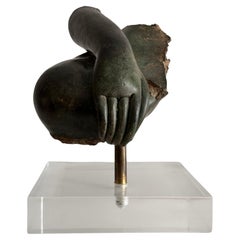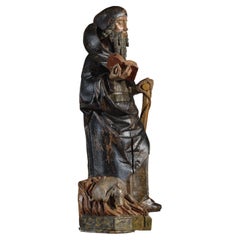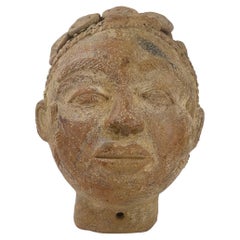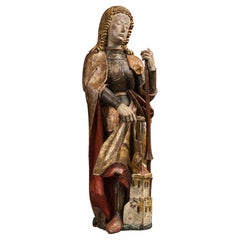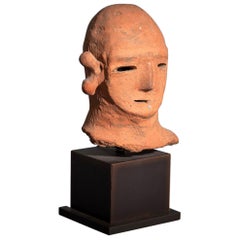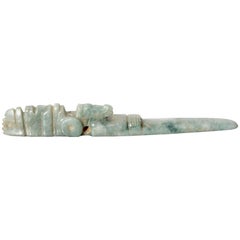15th Century and Earlier Figurative Sculptures
to
26
202
1,143
3,742
9,085
2,755
2,268
3,213
2,043
301
151
563
566
255
489
567
674
382
268
1
67
62
59
37
17
110
85
69
67
44
37
31
Height
to
Width
to
202
202
202
1
1
Period: 15th Century and Earlier
A Thai Bronze, Buddha Fragment, 15th Century
Located in PARIS, FR
A Thai bronze, Buddha fragment, 15th century.
Arm, hand and leg fragment, mounted on a plexiglas stand from 70s.
Overall: 17,2 cm.
Category
Antique 15th Century and Earlier Figurative Sculptures
Materials
Bronze
Sculpture in Polychrome Wood Representing Saint Anthony Hermit
Located in Saint-Ouen, FR
Sculpture In Polychrome Wood Representing Saint Anthony Hermit
Origin : East of France
Period : End of the 15th century
Measures: Height : 97 cm
Width : 32 cm
Depth : 26 cm
Polychrome wood
The saint is represented by an old, bearded man, dressed in a hooded monk’s habit over the tunic of his religious order. He is stood upright, holding an open book, La Règle des Antonnites, in his right hand. In the other hand, he is holding a staff in the form of the Greek letter tau with a rosary hanging down over it. At his feet lies a pig wearing a small bell around its neck.
He rests on his right leg, whilst the left advances forward as if he were about to start walking. His belted tunic, forming several rectilinear pleats, is covered by a habit which is open only at the waist, therefore revealing these pleats. He is also wearing a hooded scapular over his shoulders.
His thick hair escapes from under a distinctive hat, forming a collection of finely sculpted ringlets. This fine detail is also applied to the four long ringlets of his superb beard, which sit just below the shorter ones of his moustache.
His face is a picture of harmony, with lowered eyes and his small mouth lost amongst the abundance of hair.
At his feet on a pedestal of flames, hinting to the fire of Saint Anthony no doubt, a pig trying to scratch its ear.
Born in 251 in Upper Egypt, he withdrew into solitude at a very young age. He would have been plagued in the desert with extremely diabolical temptations.
He payed a visit to Saint Paul the hermit towards the end of his life. He was the dean of the Thébaïde anchorites, who was miraculously fed by a crow. On the day that Saint Anthony visited, the crow brought two portions of bread in its beak instead of one.
Some time after, having learnt of the death of his venerable brother, Saint Anthony went to bury him with the help of two lions.
The King of Catalonia pleaded to come and exorcise his posessed wife and children. He left Thébaïde for Barcelona. He appeared at the house of the provost André, bringing him a sow in his mouth, a monstrous piglet born without eyes. André wanted to kill it but Anthony stopped him, telling him that the poor beast wanted to ask for healing, as the King had done for his offspring.
He made a sign of the cross on the piglet and it suddenly acquired its sight and the members which it did not have at birth. After which, André, guided by Saint Anthony, exorcised the Queen of Catalonia in the same way whilst she knelt at his feet.
Théophile discovered the body of Saint Anthony wrapped in a palm fibre tunic which he had been given by Saint Paul the Hermit.
In the Red Sea Desert there are two Coptic, IV century, monasteries which stand next to each other, one dedicated to Saint Anthony, the other to Saint Paul the Hermit. They are the oldest monasteries in the Christian world.
The body of the famous hermit was transported to Constantinople and would have been transferred into the abbaye, Saint Antoine-en-Viennois, Dauphine.
The Antonnite Order was a charitable order which specialised in treating contagious diseases. The fire of Saint Anthony, was identified by doctors as a grangrenous ergotism, caused by a diet of rye bread contaminated with the parasite ergot. The effect of this is the drying out of hands and feet which then need amputation, the plague and then later syphilis. All the skin diseases came from Saint Anthony.
Saint Anthony’s pilgrimage to Dauphine rivaled that of Saint Jacques to Compostela. Thanks to the various commanderies created by the mother house, Saint Anthony’s cult spread throughout Christianity.
In order to maintain commanderies and their hospitals, the Antonnites resorted to pig farming. They enjoyed having the benefit of letting their pigs roam freely through the streets of the villages, with little bells round their necks that had a recognisable chime so that they were able to find them. This privilege was very envied by other monastic Orders.
Saint Anthony was the patron saint of several crafts such as basket makers and gravediggers.
However it is to the pig that he owes the majority of his patronages; pigkeepers, pig sellers, butchers, porc butchers, brush makers who use pig bristle and bell-ringers because of the pig bells...
Category
Antique 15th Century and Earlier Figurative Sculptures
Materials
Wood
Sculpted Clay Head of African Woman
Located in Dallas, TX
Sculpted clay head of a beautiful African woman. Light sandy brown with rough texture. A hand sculpted piece. Head adorned with a decorative circular pattern...
Category
Antique 15th Century and Earlier Figurative Sculptures
Materials
Clay
Carved Polychrome Wood Depicting Saint Florian
Located in Saint-Ouen, FR
CARVED POLYCHROME WOOD DEPICTING SAINT FLORIAN
ORIGIN : SWABIA, SOUTHERN GERMANY
PERIOD : LATE 15th CENTURY
Height : 98 cm
Length : 29 cm
Depth : 24 cm
Polychrome limewood
Very fine condition
Provenance
- Swiss collection STAEHELIN-PARAVICINI - March 1939
- Auction Jacob Hecht -18 April 1929, Berlin
- Sammlung Prof Q.A. LEIMHAAS Munich, Helbing - 26 May 1908
(Research by Thierry Fraslin)
During the Middle-Age Saint Florian was particularly popular, subject to worship in Austria -Tyrol- Bavaria and Bohemia. Embodying courage and commitment Saint Florian was invoked to protect the soul of the living against sins and to keep the soul of the deads from the purgatory.
From the mid-15th century he safeguards from water and fire. The legend has it that when he was young the saint had contained the fire of a burning...
Category
Antique 15th Century and Earlier Figurative Sculptures
Materials
Wood
Japanese Haniwa Terracotta Head of a Warrior
Located in Hudson, NY
Japanese Haniwa terracotta head of a warrior, Haniwa figures are Japanese terracotta funerary figures that accompanied the dead buried in early Japan, ...
Category
Japanese Antique 15th Century and Earlier Figurative Sculptures
Materials
Terracotta
Rare Costa Rican Jade Axe God Guanacaste Nicoya Region A.D. 1-500
Located in Dallas, TX
Fine costa Rican Jade axe god with alligator head
Guanacaste-Nicoya region, circa A.D. 1-500
Material: Jade
Of celt form depicting the mythical part human, pa...
Category
Costa Rican Pre-Columbian Antique 15th Century and Earlier Figurative Sculptures
Materials
Jade
Fine Tang Dynasty Pottery Statue of Guardian, TL Tested
Located in Greenwich, CT
A very refined, unusual and important lively modeled pottery statue of guardian, dramatic and powerful pose, early Tang dynasty, 618-907AD, comes with Oxford authentication TL test...
Category
Chinese Tang Antique 15th Century and Earlier Figurative Sculptures
Materials
Terracotta
$28,000 Sale Price
22% Off
15th Polychrome Wooden Sculpture of Saint Barbara. Mechelen.
Located in Marbella, ES
This sculpture represents the maiden of Nicomedia kept in a tower with three windows where her father locked her away. In her right hand she holds an open book that records her medit...
Category
Belgian Antique 15th Century and Earlier Figurative Sculptures
Materials
Gold
Han Dynasty Pottery Kneeling Court Attendant Figure
Located in Dallas, TX
Chinese painted pottery kneeling court attendant. A solemn downward looking tomb minqui attendant cold painted kneeling on wooden stand. Hands were originally wood and never last due...
Category
Chinese Han Antique 15th Century and Earlier Figurative Sculptures
Materials
Pottery
Unusual Tang Dynasty Persian Horse Rider Statue, Silk Road Trader, TL Tested
Located in Greenwich, CT
A fine and unusual statue of standing horse with a Persian rider. Tang Dynasty (618-907 AD) Silk Road trader from Persia, comes with Oxford authenticati...
Category
Chinese Tang Antique 15th Century and Earlier Figurative Sculptures
Materials
Terracotta
$6,200 Sale Price
20% Off
Virgin and Child in Majesty, also known as "Sedes Sapientae"
Located in Saint-Ouen, FR
VIRGIN AND CHILD IN MAJESTY, ALSO KNOWN AS "SEDES SAPIENTIAE"
ORIGIN : SPAIN, CATALOGNE
PERIOD: EARLY 13th CENTURY
Height : 95 cm
Width : 32 cm
Depth : 28 cm
Softwood
No polychromy
In the middle of the 12th century, the Virgin took her place in churches, seated in Majesty, serving as a throne for her son Jesus. She is then called Sedes Sapientiae, meaning the Throne of Wisdom.
At that time, she is not represented for herself and only exists because she has been designated as Theotokos, the mother of God, at the Council of Ephesus in 431, where the divine nature of Christ was proclaimed from his birth.
The upright and perfectly hieratic bust of this Virgin and Child in Majesty is seated on a throne-bench. She is dressed in a tunic with a rounded neckline and covered with a fine mantle placed on her narrow shoulders. The supple and natural drapery follows the lines of the body.
Large curls frame her face with delicate and regular features, a long straight nose, almond-shaped eyes, and small lips.
She supports the Infant Jesus with her left hand. Like his mother, he is dressed in a long tunic, and his little feet are visible in the folds. He holds a small sphere in his left hand, while with his right hand, he gestures in blessing. The face of Christ bears a strong resemblance to his mother’s one, and he gives a slight smile.
The position of the Child is no longer as hieratic, nor frontal or central as in the early 12th century, but his face still turns towards the faithful.
The 13th century indeed emerges as a period of transition in the artistic domain. The statuary, while retaining certain characteristics still belonging to the habits of the previous century, also develops new formal solutions.
As a result, Mary maintains a hieratic and frontal position, while her son shifts to place himself well to the left on her knee. Similarly, while the Virgin seems perfectly still, Jesus, on the other hand, appears much more animated, especially in the positioning of his hands. His left hand holds the orb, and judging by the raised right arm directed towards the faithful, one can easily imagine that he was making a gesture of blessing.
The influence of the Sedes Sapientiae from previous centuries still seems particularly prevalent in this work.
These few characteristics allow dating this Spanish Virgin...
Category
Spanish Gothic Antique 15th Century and Earlier Figurative Sculptures
Materials
Softwood
Beautiful German Pieta known as "Vesperbild"
Located in Saint-Ouen, FR
BEAUTIFUL GERMAN PIETA KNOWN AS “VESPERBILD”
ORIGIN : GERMANY
PERIOD : 15th CENTURUY
Height : 74 cm
Width : 43 cm
Depth : 22,5 cm
Good condition
Oak wood
This beautiful 15th-c...
Category
German Gothic Antique 15th Century and Earlier Figurative Sculptures
Materials
Oak
Antique French Romanesque 12th century Enthroned Madonna and Child
Located in Doha, QA
This extraordinary museum piece Enthroned Virgin Mary/Madonna with child on her lap comes from the Rhone region in France. The saint symbol and protec...
Category
French Gothic Antique 15th Century and Earlier Figurative Sculptures
Materials
Wood, Walnut
Published Pre-Columbian Nicoya Ceremonial Stone Seat, Ex Arizona Museum
Located in San Pedro Garza Garcia, Nuevo Leon
Nicoya Ceremonial Basalt Stone Seat in Shape of a Jaguar. Published in the Arizona Museum.
This large and finely carved example of Costa Rican skill and craftsmanship is in the form of a jaguar which may have been a lineage or clan symbol - as also was the crocodile - according to 16th-century Spanish conquistadors. There are so many features that make this masterpiece so unique. The most realistic depiction is the face with its head captured in a pose that is threatening and fierce.
Sculptors in ancient Central America developed elaborate metate forms that were associated with high status and wealth. They were commonly placed within graves of prominent individuals. Certain ancient rituals must have incorporated this activity and required special metates to be created for this purpose. It may have also served as a throne for the ruler, for whom the assurance of the fertility of his land and people would have been paramount.
Even today, stone metates...
Category
Pre-Columbian Antique 15th Century and Earlier Figurative Sculptures
Materials
Stone
Gothic Virgin and Child from Flanders
Located in Saint-Ouen, FR
Exhibition
Museum Cantini, 1952, The art of the Middle Ages in the Marseille collections, n°101
Provenance
Former collection Louis Bresset (before 1952)
Former collection Profe...
Category
Dutch Gothic Antique 15th Century and Earlier Figurative Sculptures
Materials
Oak
15th-16th Century Burmese Sandstone Pagoda Guardian Sculpture
Located in Kastrup, DK
Sculpture of a pagoda guardian carved from sandstone,
Originating from a Buddhist pagoda or temple in Burma, dating back to the 15th-16th century. This piece was unearthed following ...
Category
Burmese Other Antique 15th Century and Earlier Figurative Sculptures
Materials
Sandstone
Virgin and Child "Sedes Sapientiae", Seat of Holy Wisdom
Located in Saint-Ouen, FR
Virgin and child sedes sapientiae, seat of holy wisdom
Origin : Northern Spain, castile, navarre or galicia.
Period : early 13th century.
Heigh...
Category
Antique 15th Century and Earlier Figurative Sculptures
Materials
Wood
15th Century Gothic Virgin
Located in Madrid, ES
15th century Gothic Virgin
Gothic Virgin of the 15th century Virgin in carved and polychrome wood of the 15th century. In its original state, muse...
Category
Antique 15th Century and Earlier Figurative Sculptures
Materials
Wood
$16,719 Sale Price
20% Off
Rare Nursing Virgin from the 14th century
Located in Saint-Ouen, FR
RARE NURSING VIRGIN FROM THE 14TH CENTURY
ORIGIN : ITALY
PERIOD : 14TH CENTURY
Height : 60 cm
Width : 20,5 cm
Depth : 11 cm
Wood
Seated and in a very maternal position, Mary is wearing a red dress with a long, flowing cloak covering her narrow shoulders and falling down her body, with one side hugging her bust.
Her hair, half hidden under a veil, frames an oval face featuring a high forehead, a long and thin nose, a small mouth with thin lips and half-closed eyes.
Mary is carrying her son, the infant Jesus, who is wrapped in a cloak, in her lap. Jesus is being nursed by his mother, held by her left hand.
This remarkable depiction, imbued with such gentleness, is directly inspired by the iconographic theme of the Virgin and Child in Majesty. It breaks with the hieratic, impassive style of the models from the 12th and 13th centuries, adding a touch of realism. From Virgin Queen, Mary became Virgin Mother.
Linked to the development of the Marian cult, this type of representation, sometimes known as Virgo lactans, Virgin of Milk or Nurturing Virgin, remains extremely rare. This image of the Virgin Mary and the Infant Jesus is an extremely delicate representation of the intimate bond formed...
Category
Italian Gothic Antique 15th Century and Earlier Figurative Sculptures
Materials
Wood
Pair of Tang Dynasty Painted Pottery Soldiers
Located in Austin, TX
A well modelled pair of Tang dynasty painted pottery soldiers.
The warriors portrayed standing, dressed in form fitting, elaborate layered Armor with fitted helmets. The breastplate...
Category
Chinese Tang Antique 15th Century and Earlier Figurative Sculptures
Materials
Pottery
$25,000 / set
15th Virgin and Child in Polychrome and Gilt Wood. On a pedestal. Mechelen.
Located in Marbella, ES
The poupées de Malines —Mechelen dolls— are small sculptures, generally of medium bulk (with minimally worked backs), produced in the small Belgian city, situated north of Flanders b...
Category
Belgian Antique 15th Century and Earlier Figurative Sculptures
Materials
Gold
Gupta Empire Torso of Vishnu
Located in Chicago, IL
A mesmerizing Gupta Empire (mid-3rd century BCE - 543 AD) mounted terracotta torso of a standing Vishnu. Vishnu is the preserver god, which means he p...
Category
Bangladeshi Hellenistic Antique 15th Century and Earlier Figurative Sculptures
Materials
Terracotta
$18,500
A modelled pale turquoise glazed Ushabti, Ex Sotheby's
Located in ARMADALE, VIC
A finely modelled pale turquoise glazed Ushabti, Circa 26th Dynasty 664-525BC
Provenance: Sotheby’s London Lot 76 14/12/1981 for 725.00 Pounds sterling as part of a group lot.
Dime...
Category
Egyptian Egyptian Antique 15th Century and Earlier Figurative Sculptures
Materials
Stone
Virgin and Child in Majesty with a Bird
Located in Saint-Ouen, FR
Virgin and child in majesty with a bird
Origin: Southern Germany Or Austria
Period: Late 13tth - Early 14th Century
Height : 87.5 cm
Length : 32 cm
Depth : 19 cm
Lime ...
Category
Antique 15th Century and Earlier Figurative Sculptures
Materials
Wood
15th Century Burmese Sandstone Seated Monk Sculpture
Located in Kastrup, DK
Seated monk carved in sandstone, originating from a Buddhist pagoda or temple in Burma, dating back to the 15th century.
Discovered as part of an archaeological find after an earthqu...
Category
Burmese Other Antique 15th Century and Earlier Figurative Sculptures
Materials
Sandstone
13th Century Virgin and Child from Catalonia
Located in Saint-Ouen, FR
Seating on a bench-like throne the Virgin carries her child on her left knee.
She bears an important crown high on her head .The Virgin has an ovoid face with bulging eyes, straight long nose and thin lips. The hair parts in the middle and are carved as thick horizontals parallel hair strands...
Category
Spanish Gothic Antique 15th Century and Earlier Figurative Sculptures
Materials
Oak
French Statue of Jesus Christ
Located in Round Top, TX
An absolutely stunning 15th century statue of Christ from the Provenance region of France. Masterly hand carved from polychromed wood. Wonderful patin...
Category
French Antique 15th Century and Earlier Figurative Sculptures
Materials
Wood
Medieval Architectural Fragment Cornice, Corbel
Located in Vosselaar, BE
A fragment of a sandstone corbel with flat upper face, moulded transverse ledge and two protruding lobes with reserved trefoil detailing. The lower edge has fine dentiled carving and...
Category
British Gothic Antique 15th Century and Earlier Figurative Sculptures
Materials
Sandstone
Pair of Etched Dogu-Style Terracotta Figures
Located in Chicago, IL
This intricately styled pair of terracotta figurines is sculpted in the style of Japanese Dogū sculptures of the Jōmon period (10th-4th century B.C.). Reminiscent of Pre-Columbian redware figures, Dogū ceramics are known for their primitive abstract rendering of the human form and decorative geometric etchings. This pair of ceramic figurines...
Category
Unknown Pre-Columbian Antique 15th Century and Earlier Figurative Sculptures
Materials
Ceramic
$1,980 / set
Pair of Sancai Glazed Tang Dynasty Ceramic Slippers
Located in Kilmarnock, VA
A remarkably rare and unusual pair of sancai-glazed slippers dating from the Tang Dynasty (618–907 CE). These were likely created as funerary mingqi—tomb objects made to accompany th...
Category
Chinese Tang Antique 15th Century and Earlier Figurative Sculptures
Materials
Clay
14th Century Sculpture of the Head of an Angel from East of France or Rhineland
Located in Saint-Ouen, FR
This face with prominent eyes, open mouth and beautiful hairs with symetrical undulations may be the face of the Archangel Gabriel.
Category
French Gothic Antique 15th Century and Earlier Figurative Sculptures
Materials
Wood
Carved Sandstone Jain Family Group, 6th-7th Century, Uttar Pradesh, India
Located in Austin, TX
A fine and rare Indian carved sandstone stele of a Jain family group, Sarnath style, early Indian Medieval period, 6th-7th century, Uttar Pradesh, India.
Carved from a single block of buff sandstone, the stele features a Jain family group comprised of a father, mother, and two children. The family group is portrayed upon a lotus pedestal under a tall palm tree. The mother and father both seated in a relaxed pose known as lalitasana, or royal ease pose, a jovial expression on their faces. The mother holds the daughter in her lap. The younger son scampers mischievously up the trunk of the palm tree, his head turned to look back at his parents.
Above the family, nestled in a niche amongst the palm fronds, an image of a Jain Tirthankara...
Category
Indian Medieval Antique 15th Century and Earlier Figurative Sculptures
Materials
Sandstone
Statuette of a Nuragic Warrior 18th Century before J-C
Located in Beuzevillette, FR
Very beautiful statuette of a Nuraghic warrior dating from 18 century before J-C. The warrior rests on a hollow base. He carries in his right hand a weapon, surely a knife, and in his left hand a shield decorated with a four-petal flower. He is wearing a headdress decorated with two horns. This statuette was realized in bronze by a technique of casting of "lost wax" (a process of precision), and carries a label in the hollow base: "bronzetto nuragico guerriero" (bronze nuragic "warrior").
The Nuraghic culture makes its appearance in Sardinia, in the age of bronze...
Category
Antique 15th Century and Earlier Figurative Sculptures
Materials
Bronze
Hindi Sandstone Carving of Nandi / Nandikeshwara, 600-800 Years Old
Located in Kastrup, DK
Hindu sandstone carving depicting Nandi God in human form.
600-800 years old most likely older.
An exceptional sculpture carved in sandstone from te...
Category
Burmese Other Antique 15th Century and Earlier Figurative Sculptures
Materials
Sandstone
Chinese Miniature Mingqi Skirted Table
Located in Chicago, IL
This miniature ceramic table is from Shanxi Province and may have been made to represent Mingqi, a type of ancient Chinese burial good. Mingqi were plac...
Category
Chinese Ming Antique 15th Century and Earlier Figurative Sculptures
Materials
Ceramic
Colima Seated Redware Figure
Located in Chicago, IL
Beautifully aged with a rich patina and pitted wear, this seated ceramic male figure is attributed to the Colima region of Western Mexico. The stylized form of this male figure follows the conventions of Colima pottery...
Category
Mexican Pre-Columbian Antique 15th Century and Earlier Figurative Sculptures
Materials
Ceramic
Museum Quality Pre-Columbian Gold Twin Figures Pendant, circa 800 to 1500 AD
Located in San Pedro Garza Garcia, Nuevo Leon
Southern Costa Rica/Western Panama, circa 800 to 1500 AD. Gold Veraguas-Chiriqui-Diquis twin figure pendant cast by the lost-wax (cire perdu) grasping an imaginary club with their claws, with bat ears and pop out eyes and each figure ending in the shape of a jaguar tooth, symbolizing the power of the jaguar and the ability to see in the dark; The casting process did not go entirely smoothly. Part of his mold, on the side of the proper right figure (viewer's left side), did not fill with metal. The Pre-Columbian goldsmith carried out a superb repair, probably making a wax patch and pouring gate on the gold pendant, then enclosing it in a new mold and pouring in more metal. The patch is hardly visible on the outside. A modern goldsmith, who cannot do it as well, would use his gas torch to solder on a patch. The gold is of such high grade or karat, possibly unalloyed native gold...
Category
Costa Rican Pre-Columbian Antique 15th Century and Earlier Figurative Sculptures
Materials
Gold
15th Century Carved Wood Depicting Saint James
Located in Saint-Ouen, FR
The Saint depicted here is Saint James the Great.
James is the brother of St. John the Evangelist. Nothing is known of his activities after the Ascension...
Category
French Gothic Antique 15th Century and Earlier Figurative Sculptures
Materials
Oak
Saint Woman in polychrome carved wood
Located in Saint-Ouen, FR
SAINT WOMAN IN POLYCHROME CARVED WOOD
ORIGIN : ITALY
PERIOD : late 13th century
Height : 103 cm
Length : 28 cm
Width : 16 cm
Remains of polychromy
...
Category
Italian Gothic Antique 15th Century and Earlier Figurative Sculptures
Materials
Softwood
Court Lady 2, Terracotta, China, Han Period
Located in Saint ouen, FR
Court lady.
Terracotta.
China, Han period.
206 BC
H 25,5cm. W 9cm. D 7cm.
1200€.
Category
Chinese Antique 15th Century and Earlier Figurative Sculptures
Materials
Terracotta
Carved Wood Depicting Saint Martin
Located in Saint-Ouen, FR
Carved wood depicting saint martin
Origin : Germany
Period : 15th century
Measure: Height : 85 cm
Wood
Polychrome remains
Good state of conservation
Collection number on the back 26757
Our partially polychromed Saint...
Category
Antique 15th Century and Earlier Figurative Sculptures
Materials
Wood
Virgin and the Child, Mosan Region, Second Half of 13th Century
Located in Bruxelles, BE
A polychrome sculpture depicting the Virgin and the Child
Mosan region, second half of 13th century
Polychrome wood
73 x 29 X 12 cm
Provenance :
Former Belgian private collection from the beginning of the 20th century
This remarkable early artwork portrays the Enthroned Virgin and Child, also known as Sedes Sapientiae, which translates to the 'Seat of Wisdom...
Category
Belgian Medieval Antique 15th Century and Earlier Figurative Sculptures
Materials
Wood
Sculpture Dog Sichuan Pottery Han Dynasty Period China
Located in New York, NY
Sculpture Sichuan pottery walking Han dynasty period, China. A Han sculpture in the shape of a dog. Of the large number of figurines unearthed in burial sites in the city, pottery dogs are among the most unique. These marvelous animated tomb figurines...
Category
Chinese Han Antique 15th Century and Earlier Figurative Sculptures
Materials
Pottery
Virgin of the Nativity. Sculptor active in the Adriatic area, early 15th century
By Non-Standard Furniture and Lighting
Located in Milano, IT
Polychrome wooden sculpture depicting the lying Madonna, also called the Virgin of the Nativity. Mary is reclining, her right hand supporting her head, while her left hand is outstre...
Category
Italian Other Antique 15th Century and Earlier Figurative Sculptures
Materials
Wood
$27,293 Sale Price
20% Off
Wood Sculpture Depicting John the Baptist
Located in Saint-Ouen, FR
This wood scultpure showing fine traces of polychromy depicts John the Baptist, one the Old Testament’s last prophets and the first martyr of the New Testament. He is easily recognizable with the lamb he is carrying in his left hand. The way the artist has carved the face exudes a spiritual strenght inherited from previous centuries.
Description
Saint John the Baptist is depicted bare feet, seated in a hieratic manner. His elongated face is marked by a beard and a moustache. The straight nose and wide eyes indicate a Spanish origin. This asumption is reaffirmed by the Saint’s resigned expression.
His parted hair frames his face while uncovering his ears.
He wears a round collar red-orange tunic, draped onto the body and belted at the waist. A flap of his green coat covers his knees and falls down in stylized pleats.
Following iconographic rules Saint John the Baptist is pointing with his right hand the lamb seated...
Category
Spanish Gothic Antique 15th Century and Earlier Figurative Sculptures
Materials
Wood
Framed Collection of Mesoamerican Pre-Classic Period Sculptures & Arrow Heads
Located in New York, NY
Incredible collection of pre-columbian clay sculptures / figures / statues / pottery, mounted and framed. The pieces date from the pre-classic (Formative) period of Meso-American cul...
Category
North American Pre-Columbian Antique 15th Century and Earlier Figurative Sculptures
Materials
Clay, Precious Stone, Hardwood
Small Sculpture of an Angel
Located in Saint-Ouen, FR
SMALL SCULPTURE FIGURING AN ANGEL
ORIGIN : GERMANY
PERIOD : 15TH CENTURY
Height: 48,5 cm
Width : 20 cm
Depth : 12 cm
Category
Antique 15th Century and Earlier Figurative Sculptures
Materials
Wood
A Huge Christ of Pity, Normandy circa 1480
Located in PARIS, FR
A rare and large Christ of pity, or Christ in bonds.
Jesus is sitting on a rock, stripped of his clothes, awaiting his execution.
Monoxyle Ash wood carved in the round. Traces of po...
Category
French Medieval Antique 15th Century and Earlier Figurative Sculptures
Materials
Wood, Ash
Pair of Sandstone Paragode Guards
Located in Kastrup, DK
Pair of carved sandstone temple guards.
Originates from paragoda in Burma circa 15th century.
Hand carved with fine details. Each guard is in two parts...
Category
Burmese Other Antique 15th Century and Earlier Figurative Sculptures
Materials
Sandstone
$5,680 / set
Indonesian Majapahit Terracotta Head of a Male, circa 14th Century
Located in Austin, TX
A charming head of a young male, Majapahit Empire, region of Trowulan, Eastern Java, Indonesia, 13th-14th century.
The head well sculpted as a smiling, youthful male with buck teet...
Category
Javanese Tribal Antique 15th Century and Earlier Figurative Sculptures
Materials
Terracotta
Court Lady, Terracotta, China, Han Period
Located in Saint ouen, FR
Court lady.
Terracotta.
China, Han period.
206 BC
H 28,5cm. W 11cm. D 7cm.
1200€.
Category
Chinese Antique 15th Century and Earlier Figurative Sculptures
Materials
Terracotta
Indian Carved Wood of Shakti Goddess, Ca. 8th to 12th Century
Located in New York, NY
Indian Medieval Carved Wood Sculpture of Shakti Goddess
Ca. 8th to 12th Century
...
Category
Indian Anglo-Indian Antique 15th Century and Earlier Figurative Sculptures
Materials
Wood
A Polychrome and Parcel-Gilt Marble Group of the Virgin and Child
Located in London, GB
A Polychrome and Parcel-Gilt Marble Group of the Virgin
and Child
Attributed to Giovanni Di Balduccio (1317 - 1349)
Marble
Italy
Circa 1330 - 1340
SIZE: 65cm high, 28cm wide - 25½ ins high, 11 ins wide
PROVENANCE:
Possibly Trivolzio Collection, Milan
With Piero Tozzi Inc., New York
Acquired by the William Randolph Hearst Foundation for The Los Angeles County Museum (A.5832.47-42), 1947
An auction of property de-accessioned by the Los Angeles County Museum of Art to benefit new acquisitions...
Category
Italian Antique 15th Century and Earlier Figurative Sculptures
Materials
Marble
Chinese Terracotta Statue Tomb Figure East Han Dynasty
Located in Atlanta, GA
A Chinese terracotta tomb figure (Ni Yong) from East Han Dynasty (25-220 AD), likely from the area of nowadays Sichuan. It depicts a horse groomer with tool and harness in hand. Dres...
Category
Chinese Archaistic Antique 15th Century and Earlier Figurative Sculptures
Materials
Clay
Neolithic Jar on Stand
Located in Chicago, IL
This Neolithic jar originates from China 3500 BC and these funerary jars were placed in tombs and intended for use in the afterlife.
Category
Chinese Antique 15th Century and Earlier Figurative Sculptures
Materials
Terracotta
$3,200
Japanese Tumulus Period Unglazed Terracotta Haniwa of a Woman’s Head, 3rd/4th C.
Located in New York, NY
Japanese Tumulus Period Unglazed Aged Terracotta Haniwa of a Woman’s Head, 3rd/4th Century
Tumulus Period (AD 250-552)
Haniwa means “circle o...
Category
Japanese Japonisme Antique 15th Century and Earlier Figurative Sculptures
Materials
Terracotta
A Burgundy Christ, 15th century
Located in PARIS, FR
A huge Burgundy 15th century Christ on its cross.
Oak wood .
Cross is modern.
Damages, some parts missing.
98x83 cm without the cross.
Category
French Renaissance Antique 15th Century and Earlier Figurative Sculptures
Materials
Wood
Lady of the Court, Terracotta, China, Tang Period
Located in Saint ouen, FR
Lady of the court
Orange terracotta statue.
Tang period
Measures: H 20cm. L5cm. D 5cm
450€.
Category
Chinese Antique 15th Century and Earlier Figurative Sculptures
Materials
Terracotta
Pair of Wooden Praying Angels, End of 15th Century
Located in Roma, IT
Pair of praying angels is an original decorative object realized in the second half of the 15th century by North Italian or French manufacturing.
Thes...
Category
Italian Antique 15th Century and Earlier Figurative Sculptures
Materials
Wood
Chinese Miniature Mingqi Robe Rack, c. 680
Located in Chicago, IL
This miniature robe rack made out of glazed ceramic is called a mingqi or “spirit object.” Mingqi were buried in tombs and represented all of the things the ...
Category
Chinese Tang Antique 15th Century and Earlier Figurative Sculptures
Materials
Ceramic
Recently Viewed
View AllMore Ways To Browse
Lucite Head Sculptures
Roman Soldier Bronze Sculpture
Italian Angel Statues
Lead Figurines
Marble Girl Nude
Miguel Berrocal Puzzle Sculptures
Narcissus Bronze
Narcissus Sculpture
Pharaoh Statue
Roman Centurion
Vendome Marble
Vintage Car Mascots
Vintage Mannequin Head
Wood Stump Sculpture
A Fayral
Alcove Sculptures
American Indian Statue
Angels Playing Instruments
